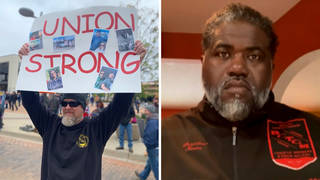
By Amy Goodman with Denis Moynihan
The holiday season is upon us. Sadly, the big retailers are Scrooges when it comes to paying their staffs. Undergirding the sale prices is an army of workers earning the minimum wage or a fraction above it, living check to check on their meager pay and benefits. The dark secret that the retail giants like Wal-Mart don’t want you to know is that many of these workers subsist below the poverty line, and rely on programs like food stamps and Medicaid just to get by. This holiday season, though, low-wage workers from Wal-Mart to fast-food restaurants are standing up and fighting back.
“Wal-Mart was put in an uncomfortable spotlight on what should be the happiest day of the year for the retailer,” Josh Eidelson told me, reporting on the coordinated Black Friday protests. “These were the largest protests we’ve seen against Wal-Mart … you had 1,500 stores involved; you had over a hundred people arrested.” Wal-Mart is the world’s largest retailer, with 2.2 million employees, 1.3 million of whom are in the U.S. It reported close to $120 billion in gross profit for 2012. Just six members of the Walton family, whose patriarch, Sam Walton, founded the retail giant, have amassed an estimated combined fortune of between $115 billion-$144 billion. These six individuals have more wealth than the combined financial assets of the poorest 40 percent of the U.S. population.
Wal-Mart workers have been organizing under the banner of OUR Walmart, a worker initiative supported by the United Food and Commercial Workers union. Workers have taken courageous stands, protesting their employer and engaging in short-term strikes. Wal-Mart has retaliated, firing many who participated. One of those fired was Barbara Collins, who worked for eight years at the Wal-Mart in Placerville, Calif.
“I was terminated for speaking out,” Collins told us on “Democracy Now!” On Nov. 18, the National Labor Relations Board (NLRB) ruled that the strikes were protected worker actions. Collins, who was speaking to us from Bentonville, Ark., where she was protesting Wal-Mart at its world headquarters, told us: “The NLRB ruling is just overwhelming. We are really excited that they found that we’re telling the truth, that they broke the law, and we want to be reinstated.”
The public-policy think tank Demos issued a report, “A Higher Wage is Possible: How Walmart Can Invest in Its Workforce Without Costing Customers a Dime.” Demos analyzed a growing demand from the Wal-Mart worker movement for a guaranteed base salary for full-time workers of $25,000 per year. “We found talking to Wal-Mart workers over and over again that their wages give them just enough to meet their basic needs, and at the end of every month, they’re making critical trade-off decisions,” Catherine Ruetschlin, one of the report’s co-authors, told us. “Determining whether they’re going to get medicine or pay their school fees or put food on the table or keep their electricity on.” The report explains that “if Walmart redirected the $7.6 billion it spends annually on repurchases of its own company stock, these funds could be used to give Walmart’s low-paid workers a raise of $5.83 an hour,” meeting the salary goal of the workers.
Parallel to the Wal-Mart campaign is a drive for higher wages in the fast-food industry. In more than 100 cities, workers are organizing protests and strikes … and winning. In SeaTac, the Washington state municipality where the Seattle-Tacoma Airport is located, voters approved a local minimum wage of $15 an hour. As with Wal-Mart workers, fast-food giants like McDonald’s and Yum Brands (which owns KFC and Taco Bell) all feast from the public trough: Their workers, earning poverty wages, depend on public-assistance programs like food stamps and Medicaid, while their enormous CEO benefit packages qualify for corporate tax deductions, as reported by the Institute for Policy Studies this week.
The current federal minimum wage is $7.25, equivalent to an annual income of $15,080 for a full-time worker. If the minimum wage had kept up with inflation since 1968, it would be $10.74, enough to lift a family of three above the poverty line. If the wage had grown at the same pace as worker productivity (since each worker per hour produces much more now than in decades past), it would be $18.72 per hour. And if the minimum wage had skyrocketed at the same pace as wages for the top 1 percent, it would be $28.34. These figures from the Economic Policy Institute explain why President Barack Obama is pushing for an increase in the minimum wage.
Progress on the minimum wage, and on workers’ rights at Wal-Mart, McDonald’s and the other multinational corporations that depend on public subsidies for their workers, will come not from a stroke of the president’s pen, but from the concerted efforts of workers and their allies, from the streets to the voting booths.
Amy Goodman is the host of “Democracy Now!,” a daily international TV/radio news hour airing on more than 1,200 stations in North America. She is the co-author of “The Silenced Majority,” a New York Times best-seller.
© 2013 Amy Goodman
Distributed by King Features Syndicate











Media Options